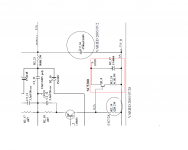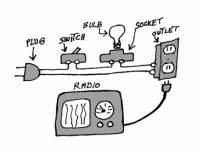I recently repaired this amplifier. It was shutting down and blowing fuses. I replaced all output transistors, fuses and a lot of resistors which were recommend changes by Manufacturer. Could you please hep me to determine why R2-24 is still causing a problem? I powered amplifier without speakers or input. R2-24 burned in 1 second. I turned of amp immediately.
Thanks
Thanks
Attachments
Last edited:
Hi,
Check resistor R2_14. It is possible is open. That will make the base of Q2_8 positive. I think it should be negative to disable the Q2_8. To check it remove R2_24 and check the voltage at the base of Q2_8.
Check resistor R2_14. It is possible is open. That will make the base of Q2_8 positive. I think it should be negative to disable the Q2_8. To check it remove R2_24 and check the voltage at the base of Q2_8.
R2-14 is definitely open. It was a new resistor yesterday. Thanks for your expertise. The traces are very tiny so I will look for excessive solder and study the schematic to the best of my ability. I would sure like to know what caused R2-14 to burn as well.
What are the possibilities?
What are the possibilities?
Trust me on this, new or not if R2_14 is open then SC5200 is bad. Shorted Q2_8 puts 73 volts right across R2_14. No other path does that can be seen on schematic as posted. Measure ohms between base of Q2_8 and ground to check out the SC5200. Bet you find a dead short.
Doc
Doc
Thanks so much. Is it possible that I have oversoldered? Otherwise what would cause SC5200 to short? Thanks so very very much. You are really helping me to understand.
From what I can see R2-14 is parallel to Q2-2 (cutoff schematic) I am 90% certain that Q2-2 is bad. I am going to pull Q2-2 and Q2-8 and check them both.
I have for lack of confidence in my testing skills, replaced all resistors and transistors again. I would rather do things right then my current component swapping method. I am about to power up amplifier. Glass is half empty and I am expecting a little mushroom cloud. Board is mounted, transistors are mounted to heatsinks. I have powered the amp without fuses and all is well. Can I substitute a lower transformer voltage to look for anomalies or should I hit switch and watch for sparks?
If you have a variac you can bring the amp up slow.... assuming no power on delay relay. Next trick is to replace amp fuses with much lower test values. Myself I sub in a current limited supply and see that all is copasetic before bringing things up on the mains.
Doc
Doc
I don't have a variac. First attapt, I blew fuses. Last time, fuses didn't blow but a resitor in series with output trans burned. Transformer puts 56-0-56 in to each channel. What if I were to feed 25-0-25 and look for heat. I am just guessing here. I like the lower fuse idea. Is current dependent on how hard it is being driven? If so, I could put in some 2a and idle it. The resitor that burned was to the supply of the output transistor.
Thanks
Thanks
Maybe It's getting worse or I made headway. I just flipped switch and all four 5 amp fuses burned instantly. +73v -73v left and +73v -73v right
Hi,
To blow all the fuses you must have something very wrong. Leave the fuses out and check the fuses load side to ground for each fuses. See if you a have a short in each one.
To blow all the fuses you must have something very wrong. Leave the fuses out and check the fuses load side to ground for each fuses. See if you a have a short in each one.
- Status
- Not open for further replies.
- Home
- Amplifiers
- Solid State
- Amplifier burning resistor.

